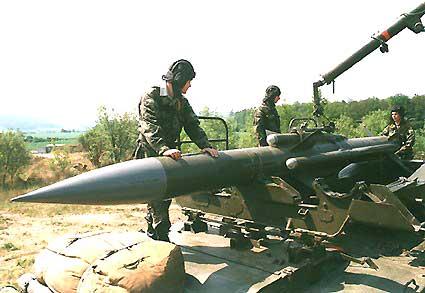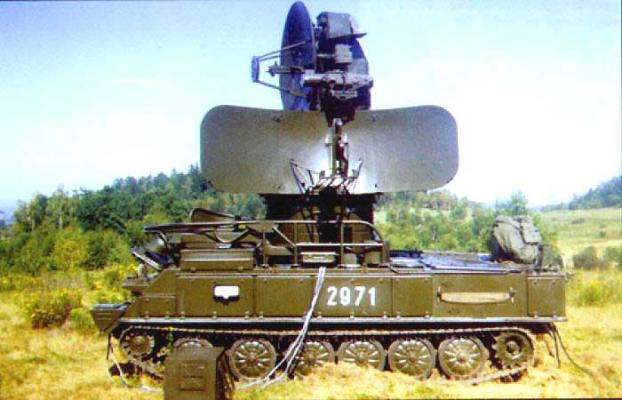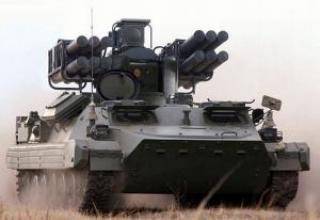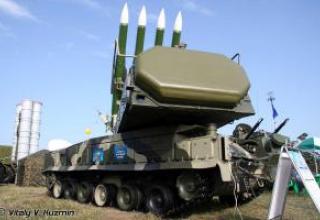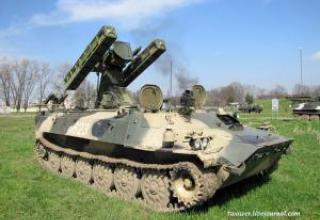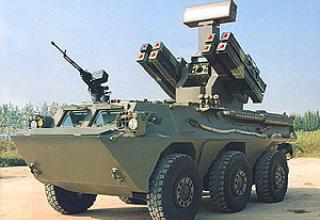The development of the "Cube" SAM system was set by the Decree of the CPSU Central Committee and the USSR Council of Ministers dated July 18, 1958. The "Cube" self-propelled air defense missile system (2K12) is designed to protect the Ground Forces, mainly - tank divisions, from air attack means flying at medium and low altitudes. The "Cube" complex was intended to defeat air targets flying at speeds of 420-600 m/s at altitudes from 100-200 m to 5-7 km at ranges of up to 20 km with the probability of hitting the target with a single missile of at least 0.7.
The designer of the "Cube" SAM system as a whole was determined by the Research Institute of Instrument Engineering, the same organization worked on the creation of a self-propelled reconnaissance and pointing unit (Chief Designer of the unit A.A.Rastov) and a semi-active radar missile homing head (Chief Designer of the head Yu.N.Vekhov, since 1960 - I.G.Hakobyan). V.V.Tikhomirov was appointed the Chief Designer of the complex; the self-propelled launcher was created under the supervision of A.I.Yaskin, Chief Designer of the Sverdlovsk SSC-203; the tracked chassis for the combat vehicles of the complex were created at the Design Bureau of Mytishchi Machine-Building Plant (MMZ) of the Moscow Regional SSC; the Chief Designer of the chassis was N.A.Astrov. MMZ specialists developed the chassis on the basis of ZSU-23-4 antiaircraft self-propelled installation in two modifications: for placing the launcher and for the detection and guidance station. Weight of the chassis of the detection station is 15 tons, lifting capacity up to 5 tons. Calculated maximum speed - 50 km/hour. Combat weight of a self-propelled starting installation with three missiles - 19 tons. It was planned to install gas turbine power supply units with capacity: 40 hp for the launcher, 80 hp for the detection station. There was a duplication of power supply with power take-off from the main engine of the chassis. According to the data by 25.09.1962, Mytyshchynsky plant had developed a special wheeled chassis to accommodate the missile system "Cube", to increase the durability of the chassis of the complex and some reduction in its weight.
The anti-aircraft guided missile for the complex was assigned to create the Design Bureau of Plant №134 GKAT, the development of the rocket complex "Cube" was started under the guidance of Chief Designer I.I.Toropov.
The first tests of the complex, which began in late 1959, revealed a number of shortcomings:
- insufficient ability to drive the CNS and poor quality of its fairing;
- unsuccessful design of air intakes;
- poor quality heat protection coating of the inner surface of the titanium housing of the afterburning chamber, steel was used instead of titanium in the result.
It was followed by the so-called "orgvoda". In August 1961 I.I.Toropov was replaced by A.L.Lyapin, in January 1962 the place of the three times laureate of the Stalin prize V.V.Tikhomirov was taken by Y.N.Figurovsky. However, the dispersion of the initiators of the development did not lead to an acceleration of work. By early 1963, of the 83 missiles launched, only 11 were equipped with GSN. However, only 3 launches were successfully completed.
In 1964, missile launches were more or less standard, but ground-based SAMs have not yet been equipped with communication equipment, linking the mutual location. By mid-April 1964, the first successful missile launch was conducted, equipped with a combat unit. It managed to shoot down the target - IL-28, flying at a medium altitude. Later launches were usually successful, and the accuracy of pointing the missiles at the target simply delighted the participants of the tests. From January 1965 to June 1966 at the Dongguz range (range commander M.I.Finogenov) under the guidance of a commission headed by N.A.Karandeyev, conducted joint tests of the complex.
The Decree of the CPSU Central Committee and the USSR CM of January 23, 1967 the complex was adopted by the Air Defense Forces of the Army.
Composition:
The Cube SAM system includes the following combat equipment:
- Anti-aircraft guided missile 3M9 (see diagram);
- 1C91 self-propelled reconnaissance and pointing machine;
- Self-propelled launcher (SPS) 2P25.
Surface-to-air missile 3M9 Like the Krug complex, the missile 3M9 is designed as a "rotary wing". However, unlike the ZM8 missile, the ZUR 3M9 rocket was additionally equipped with stabilizer rudders. As a result of the implementation of this scheme was able to reduce the size of the swivel wing, reduce the necessary power steering machines and use a lighter pneumatic drive instead of hydraulic.
The missile was equipped with a 1SB4 semi-active homing radar head, which captured the target from launch, accompanied it at Doppler frequency in accordance with the speed of approaching the missile to the target, and generated control signals to point the SAM at the target. The CLO was placed at the front of the missile, with the antenna diameter approaching the middel size of the ELISA. A combat unit was installed behind the CLO, followed by autopilot equipment and engine.
Pointing of the missile 3M9 (3M9M) on the target is made by the method of proportional navigation, which is that the flight of the missile to the point of encounter with a moving target occurs on a trajectory in which the angular velocity of the velocity vector of the missile is proportional to the angular velocity of rotation of the line "missile-target" (line of sight).
Initial pointing of the radar head antenna at the target, when the missile is on a self-propelled launcher, is made on the signals from the counting and solving device located on the LSU.
The missile was equipped with a combined propulsion system. Ahead of it there was a gas generator chamber with the engine charge of the marching (second) stage 9D16K. The combustion products of the gas generator charge entered the afterburning chamber, where the remains of fuel were burned in the air stream entering through 4 air intakes. The air intakes input devices, designed for supersonic conditions, were equipped with conical central bodies. At the starting section, before the marching engine was switched on, the air intakes' outlets to the afterburning chamber were covered with fiberglass plugs.
In the afterburning chamber a solid fuel charge of the starting stage was placed - an ordinary checker with armored ends (1.7 m long and 290 mm in diameter, with a cylindrical channel of 54 mm in diameter) of VIC-2 ballistic fuel weighing 172 kg. Since gas-dynamic conditions of solid fuel engine operation in the starting section and SVAD in the marching section required different nozzle geometry of the afterburning chamber, at the end of the starting stage (duration of 3-6 seconds) it was envisaged to shoot off the inner part of the nozzle apparatus with fiberglass grating holding the starting charge.
The 3H12 fragmentation and blast warhead with a mass of 57 kg (developed by NII-24) was detonated by a command of the 3E27 autodynamic two-channel continuous radiation radio detonator created at NII-571.
The length of the missile was about 5.8 m with a diameter of 330 mm. To ensure transportation of the assembled missile in container 9Ya266 the folding of left and right stabilizer consoles towards each other was used.
1C91 self-propelled reconnaissance and pointing machine
The 1C91 self-propelled reconnaissance and pointing unit consisted of two radars - the 1C11 airborne target detection and designation radar and the 1C31 target and illumination tracking radar, as well as means of target identification, navigation, and top linking, Mutual orientation, radio and television communication with self-propelled launchers, television and optical vizier, autonomous power supply (gas-turbine generator was used), antenna lifting and horizonization systems.
The radar antennas were located in two tiers - at the top of 1C31, below - 1C11 - and could rotate along the azimuth independently of each other. To reduce the height of the self-propelled vehicle on the march, the cylindrical base of the antenna devices was removed inside the body of the track machine, and the antenna device of the 1C31 radar was turned down, being located behind the antenna of 1C11 station.
The 1C11 station was a coherent-pulse radar with a circular view (15 rpm) of the centimeter range and two independent waveguide receiving and transmitting channels operating at different carrier frequencies, whose emitters were installed in the focal plane of the single antenna mirror. Detection, identification of the target and target designation of the tracking and illumination station were provided when the target was located at ranges from 3 to 70 km and at altitudes from 30 to 7000 m with a pulse power of 600 kW in each channel, the sensitivity of the receivers of the order 10E-13 W, azimuth beam width of about 1 degree and the total viewing sector at an angle of about 20 degrees. To provide noise immunity in 1C11 stations were provided:
- Moving Target Selection Systems (MTS) and Non-Synchronous Pulse Interference Suppression Systems
- manual gain adjustment of the receiving channels;
- modulation of pulse repetition frequency;
- frequency tuning of transmitters.
Station 1C31 also consisted of two channels with emitters installed in the focal plane of the parabolic reflector of the single antenna - target tracking and target illumination. On the channel of target tracking the station had a pulse power of 270 kW, the sensitivity of the receiver is about 10E-13 W, beam width of about 1 degree. Mean square error (RMS) of target tracking by angular coordinates was about 0.5 d.e., by distance - about 10 m. The station could capture a Phantom-2 aircraft with a probability of 0.9 at a range of up to 50 km. Protection from passive interference and reflections from the ground was carried out by the SDC system with the program change of pulse repetition frequency, from active interference - using the method of monopulse direction finding of targets, the system of indication of interference and tuning the operating frequency of the station. In case if 1C31 station was still suppressed by interference, it was possible to accompany the target by angular coordinates with the help of a television optical visier, and information about the distance was received from the radar 1C11. The station provided for special measures for the sustainable tracking of low-flying targets. The target illumination transmitter (and the reference signal irradiation of the missile's SOS) generated continuous oscillations and ensured the reliable operation of the missile's SOS.
The equipment of the self-propelled reconnaissance and pointing unit was placed on the GM-568 chassis. The weight of self-propelled reconnaissance and pointing unit with the combat calculation of 4 persons was 20.3 tons.
2P25 self-propelled launcher
On the 2P25 self-propelled launcher (see diagram), placed on the GM-578 chassis, there were installed the gun carriage with three guides for missiles and electric power tracking drives, counting and solving device, navigation equipment, top links, telecode communication, ZUR pre-start control, autonomous gas-turbine electric unit. Electrical connection of the self-propelled launcher with the rocket was made by means of two rocket connectors, which were cut off with the help of special rods at the beginning of the rocket's movement along the guide beam. The prelaunch guidance of the missiles in the direction of the preemptive point of encounter of the SAM was carried out by the carriage drives, which worked out the data from the self-propelled reconnaissance and guidance unit, which were received by the self-propelled launcher by means of a radio telemetry communication line.
In the transport position, directional sounders were located with the tail part forward in the course of the self-propelled launcher. The weight of the self-propelled launcher with three rockets and a combat crew of 3 persons on board was 19.5 t.
See on our website:
Characteristics:
| Defeat zone, km: - at a distance - in height - as defined in |
6-8..22 0,1..7 up to 15 |
| Probability of hitting a target like a fighter jet of the same SSD. | 0,7 |
| Maximum target speed m/s | 600 |
| Response time, s: | 26..28 |
| ZUR flight speed, m/s | 600 |
| The length of the rocket, mm | 5850 |
| Wingspan, mm | 932 |
| Swing of stabilizers, mm | 1214 |
| The diameter of the rocket body, mm | 330 |
| Diameter in the air inlets, mm | 561 |
| Missile launch weight, kg | 605 |
| Weight of combat unit, kg | 57 |
| Target channeling | 1 |
| Zurich canalization | 2-3 |
| Deployment time (closures), mines | 5 |
| The number of SSDs on a combat vehicle | 3 |
| 3M9 Main Rocket Units and Units Operation Guarantee Lifetime | |
| Service life of the radar homing head (SHH) 1SB4 in the preliminary switching mode, hours | 295 |
| Service life of the radar homing head (Homing Head) 1SB4 on full power, hours | 55 |
| Autopilot Operating Resource (AP) 1SB6, hours | 55 |
| Operating life of radar fuse (RV) 3E27, hours | 55, including 9 hours with each motorcade included. |
| Turbogenerator operation resource (TG) 9B137 | 2 hours and 45 minutes |
Testing:
Cube" SAMs were produced from 1967 to 1982, were exported and were widely used in combat operations. Its first success came in 1973 during the Arab-Israeli War, when the Egyptians destroyed almost half of the Israeli Air Force with the fire of these complexes. These huge losses forced the Israeli Air Force to seek means of struggle and tactics to counter this threat. To a greater extent, the tactics found were based on direct attack by SAMs, using the complex's disadvantages of limited intercept capabilities at low altitudes and low radar scanning speed (see chart of attack by one plane, attack by a couple of planes).
By the end of the hostilities, the final outcome was as follows: the loss of 110 Israeli aircraft, destruction of 40 air defense systems of various types.
In 1982, when the war in Lebanon, codenamed "The World of Galilee", began, this reliable weapon became obsolete. Syria's air defense system was opposed by Israel to a coordinated "real-time" war system; a war in which air reconnaissance, distribution of results to attacking forces, and strikes themselves were conducted almost simultaneously in quick succession, combined with extensive use of air defense systems. Unmanned aerial vehicles were widely used (see diagram). This allowed the Israelis to destroy almost all SAM batteries in the area, thus depriving the Syrian armoured forces of air cover.
The Kuban SAMs were also in service with the Yugoslav air defence forces in 1999 during the barbaric NATO bombing of that country. By that time, they had already been well studied by specialists from Western countries during previous armed conflicts, so the task of fighting them was much easier. In the course of gaining air superiority by NATO aircraft, most of the attacks were carried out at night when the optical and television channels of the SAMs were not functioning. As a result, cube SAMs proved vulnerable to modern high-precision weapons. For example, their missile guidance stations were usually completely suppressed by powerful active noise interference over the entire operating frequency range. Calculations of SAMs had to detect, capture and escort targets by tele-optical imaging, which was ineffective in night-time combat conditions. When the anti-radar missiles or guided bombs were hit, they were usually destroyed together with the personnel, as both the detection radar and the combat calculation of the Cube SAMs are placed on the same landing gear. In addition, the armour protection proved to be ineffective, and it was simply absent in the upper part of the vehicle, while the impact of high-precision weapons was coming from the upper hemisphere. Three batteries of the Cube SAM system were lost in the course of the air raids.
In Slovakia, the "Cube" ("Cube M2") system, which includes a 2P25M2 self-propelled launcher with three 3M9ME or 3M9ME rockets, has been in operation and is still in operation.
Sources:
- Вестник ПВО
- О. Божьева "УРОКИ БАЛКАНСКОЙ ВОЙНЫ" "Независимое военное обозрение"
- Марио де Арканжелис "Радиоэлектронная война".
- Ракета 3М9 (3М9М). Техническое описание 3М9 (3М9М)-ТО. Редакция вторая. - 1981. - С.8-10.
- Stanislav Szabo, Miroslav Gyürösi, Michal J. Stolár. SLOVENSKÉ VOJENSKÉ LETECTVO V OBRAZOCH 15. výročie (1993-2008). SLOVAK AIR FORCE IN PICTURES – 15th Anniversary (1993 – 2008). – Magnet Press, Slovakia, 2008. – P.83,154-157.
- Дело 51. Сводные данные и материалы по уровню реактивного вооружения. Начато 25.07.1962 г. Окончено 04.11.1962 г. / АННОТАЦИЯ гусеничного самоходного шасси зенитного реактивного комплекса "Куб". 25.09.1962 г. Документ без подписей и мест для них // РГАЭ. Ф. 298. Оп. 1. Д. 3058. Л. 50,50об.

